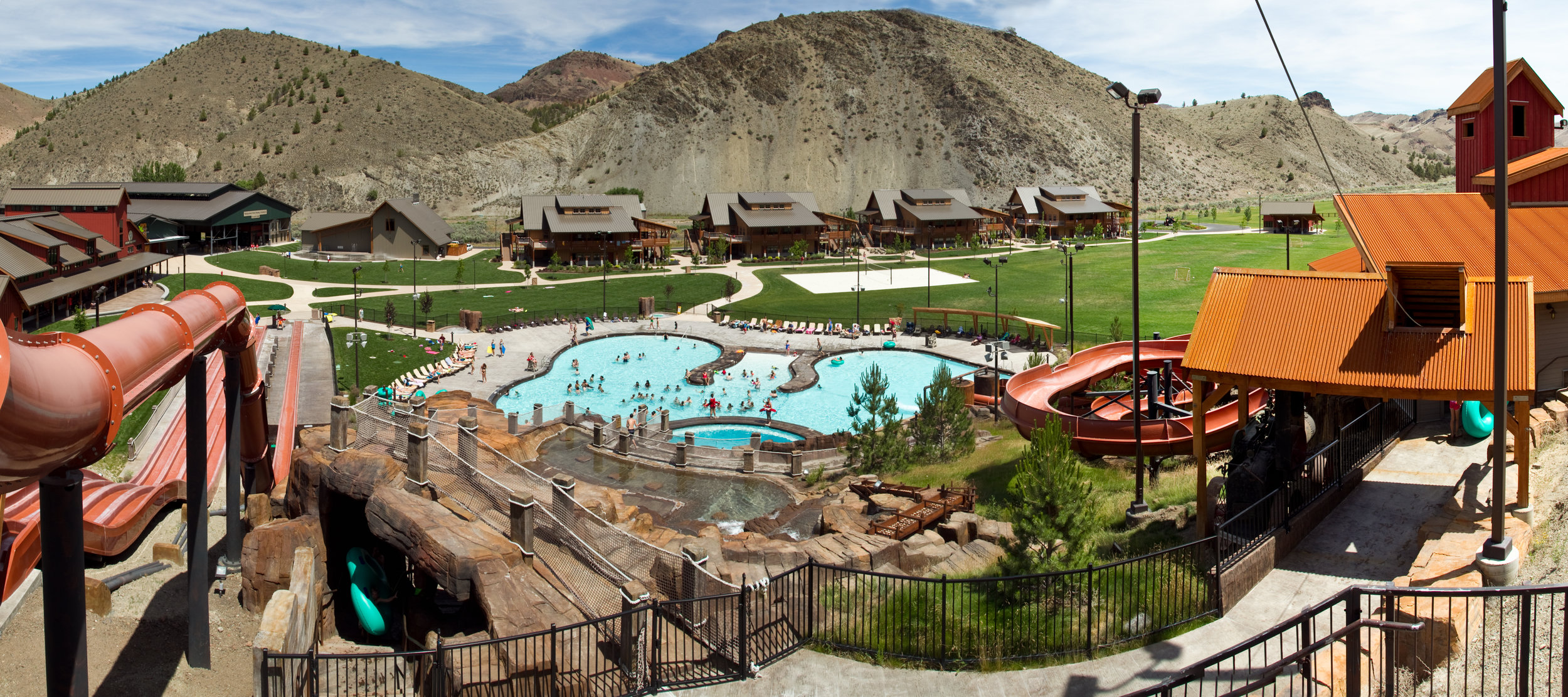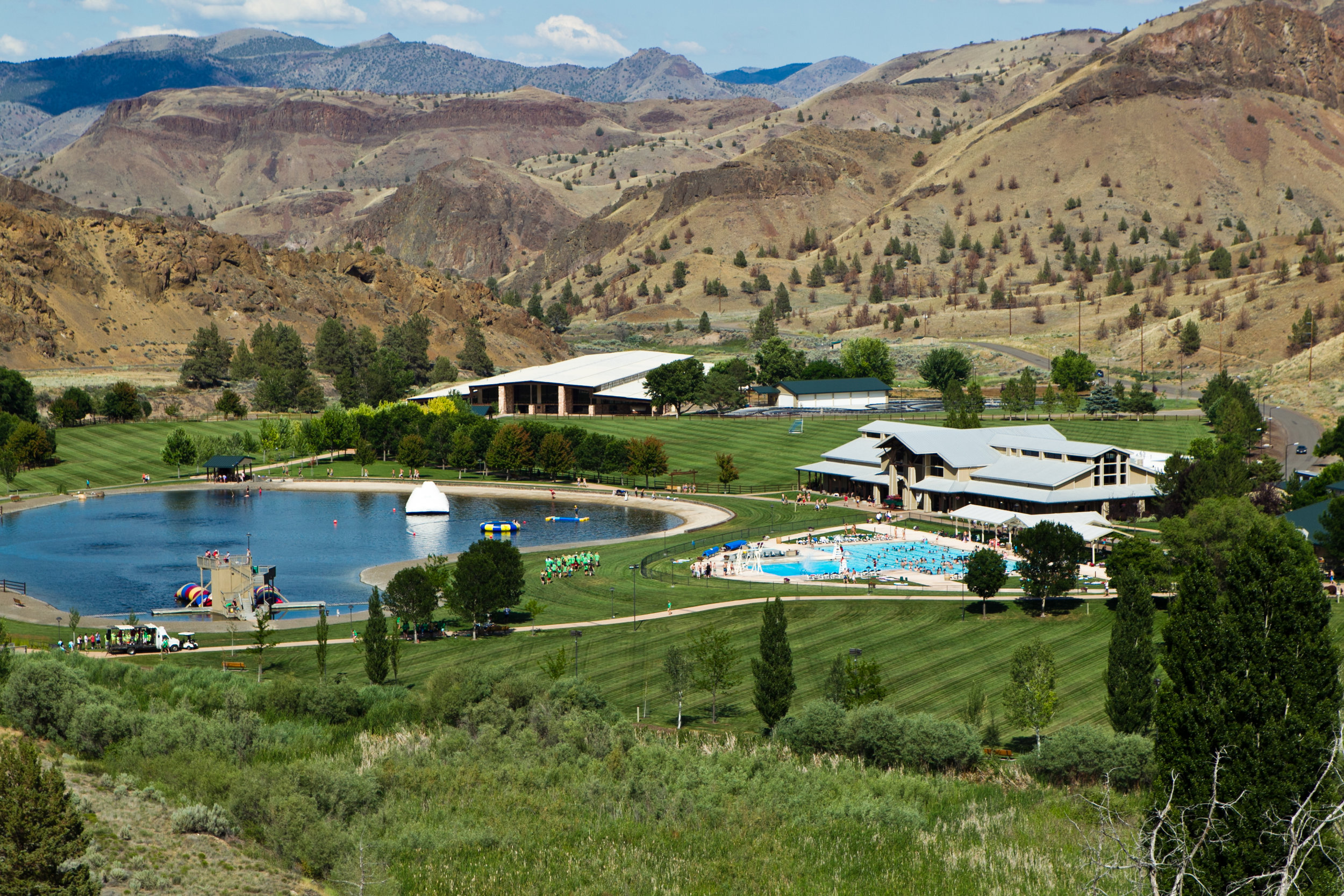Inside the Christian camp that used to be Oregon's infamous cult ranch
Cabins line the road behind a massive pool and small waterpark. Photo provided.
THE DALLES, Ore. — A gravel road winding through Oregon’s high desert may not look like much today, but back in 1982, this 15-mile highway was world-famous.
A lot had changed since I’d driven this way as a reporter for a small newspaper based near Portland, Ore. At the time, I was reporting on an infamous cult that had taken over this isolated country, calling it Rajneeshpuram and flooding central Oregon with thousands of saffron-robed disciples.
Everything within my eyesight was once called Rancho Rajneesh, a 64,229-acre spread bought for $5.75 million on July 10, 1981, then put up for sale in 1985 as state and federal officials were closing in on the place. It was named after Bhagwan Shree Rajneesh, the infamous “sex guru” and spiritual leader from Pune, India, who formed a city-state in central Oregon. The place cratered because of the paranoia of its leaders, the spending habits of the guru and wild (and illegal) schemes like wiretapping, immigration fraud and poisoning the residents of The Dalles, Oregon.
The latter incident, which involved salmonella sprinkled into the contents of several local restaurant salad bars, didn’t kill anyone, but 751 people were poisoned, and 505 people filed claims against the cult. It still stands as the largest terrorist bioweapon attack on US soil.
As reported in a 2018 Netflix original documentary Wild Wild Country on the place, the site eventually became a Christian camp called the Washington Family Ranch. It opened 20 years ago this month, and anyone can visit. It’s run by the Colorado Springs-based youth ministry Young Life.
On a foggy spring morning, it took me an hour to drive the 32 miles from Fossil, the nearest sizable town. From a paved state road, one turns south onto a bumpy gravel road past several farms. Once the road enters Ranch property – about four miles in – it improves a tad and there are plenty of signs to guide the driver past multiple curves as vista after vista opens up.
This is arid hill country, marked with sagebrush, juniper and bunch grass; pocked with basalt canyons and overseen by volcanic plugs from a past age when Oregon was far more geologically active. Some 500-600 head of cattle roam the property.
My car was quickly covered with mud. Thankfully, the road turned back into asphalt upon entering the core of the property where there’s a large sign and an air strip, installed by the Rajneeshees. Around a bend in the road was the main office and beyond that was an expansive collection of buildings that house almost 9,000 high school and middle school students over 12 weeks each summer.
I asked Andy Squires, the property manager, if they ever thought the camp would get this far.
“No,” he said. “It’s been a God miracle.” He was there on June 13, 1999, when the camp opened. They had just filled the swimming pool when the first kids arrived. (If you wish to know more details, read this Oregonian article about the ranch’s resurrection.
Dressed in a dark blue fleece jacket the day I came, Squires explained how the acquisition of the camp was considered miraculous at the time. The Rajneeshees had invested an estimated $120 million into the settlement by building accommodations and providing municipal services enough for a small city. When I saw it, there was a sea of disciples dressed in all shades of red, pink and orange who gathered in places like Magdalena Café, Zarathustra Fields and Lao Tzu Grove.
Everyone had some kind of Hindu name plus they were wearing malas, which were 108-beaded necklaces with the guru’s portrait. Each afternoon, everyone lined up alongside the road to wait, hands clasped in prayer, for the guru to drive by in one of his 93 Rolls Royces kept at the camp. He was in “silence” when I was there, so I only got to interview his disciples.
Bhagwan Shree Rajneesh (who later went by the name “Osho”) left the US in November 1985, after pleading guilty to immigration fraud. His followers dispersed after that. He died in 1990 in India. The property lay desolate for more than a decade, after the guru’s tents, airplanes, Rolls Royces and jewelry were sold off and some of the 300 buildings on the property were taken by the Montana-based Church Universal and Triumphant.
Antelope, the closest town nearest to the commune and a place that was briefly named Rajneesh by the guru’s followers, reverted back to its original name and sleepy existence.
A 1987 Los Angeles Times piece described how the land was first marketed at $44 million, then marked down to $28.5 million when no one stepped up to buy it. Finally, Montana businessman Dennis Washington (hence the property name “Washington Family Ranch”) bought “Big Muddy” in 1991 at a property tax foreclosure sale with the idea of using it as a destination resort. Because of zoning issues, he changed his mind, donating the property to Young Life a few years later.
Today, it’s a different world. The place is divided into a high school area — Canyon — and a middle school area — Creekside.
The huge dining hall at Canyon, which is set up like a Western town with faux store fronts, was built in 2000 and feeds 900. Creekside, which comes with its own waterpark, was added in 2011 at a cost of $30 million donated by a foundation set up by Dennis Washington.
The Rajneesh Mandir meeting center, at 88,000 square feet, where the guru used to have his mass meditation sessions, is now a sports center that includes four basketball courts, a skate park, weight room, a go-cart track and foam pit.
“We try to give kids adventures and experiences they might not have every day,” Squires said.
Most impressive is the lush landscaping and the spring-fed pond, into which three zip lines dump screaming kids. An enormous swing-and-ropes course is on its far side. As for the adjacent pool - in case you forget this is a Christian place - the lanes are marked with crosses.
A reservoir built by the Rajneeshees already provided irrigation and drinking water. The entire watershed is on Young Life’s property.
Young Life camps, of which there are 33 across the US and Canada, are typically a week long with plenty of daytime fun mixed with evangelistic talks in the evenings. About 150 people live on site year-round in about 40 staff condos. Two teachers also live there, schooling 23 students in its K-8 classes. Formerly, high school kids took correspondence courses or were homeschooled. The Bend Bulletin recently reported that for the first time this fall, several students will make the 90-minute commute to the high school in Madras, a city to the west of the camp.
I’d made a prior appointment to be there, which one needs for a tour when it’s not high season from June through August. There are also alternative camps, such as one for 150 teen moms; men’s and women’s retreats in the adult guest lodge plus a game hunting program for the deer and elk in the area.
But for day visitors, there’s no onsite food for purchase, so stock up in advance. Tours take about an hour. Take one past the original farmhouse, water tower and barn that was on the property back when it was known as “Big Muddy,” a ranch. The road that runs through the camp is a public access route that leads south (over very rough terrain) to the fossil beds near Painted Hills, a set of low-slung hills stratified with yellow, black and red stripes.
Interest in the property, said Squires, “comes in waves,” the Netflix series providing the latest round of curiosity seekers. He’s lived 17 years on the property and raised two children there. Young Life was interested in the property, he said, because its other summer camps across the country were full and the organization was looking to expand. Even though much of it lay in ruins years after it ceased being known as part of Rajneeshpuram, the basic structures, such as water lines and the air strip, were there.
It’s now the largest Young Life camp in the country. In an era when other organizations, such as the Girl Scouts, are closing camps, Young Life has purchased five camp properties since 2014. The Christian organization accommodated 59,635 youths at its camps in 2018.
The ministry has greatly benefited from resort properties that were acquired by people with deep pockets, then donated to Young Life after the places failed to take off. One of Young Life's other prize properties is the Malibu Club, which was built as a resort for Hollywood's elite in the 1940s at the mouth of the Princess Louisa Inlet in British Columbia. Owner Tom Hamilton, who made a fortune selling airplane propellers to the Nazis in the mid-1930s, sold Malibu to Young Life below market value after a visit to a youth camp won him over to the work of youth outreach. I attended a women’s retreat there in the fall of 2018; the first time I’d seen the place since I volunteered there as a college student in the late 1970s. The place, which is amidst fabulous scenery, has done extensive remodeling in recent decades and can also be visited by the public under certain conditions.
Just know that whichever camp you end up at, there will be a fascinating story behind how it came to be.
If you plan to go
Where to eat: Grandma’s Café in Antelope, 7 a.m.-5 p.m., closed Tuesdays and Wednesdays. Can’t miss it when you drive thru on the town’s main street. The mayor runs the place.
Where to stay: Hyatt House Bed & Breakfast, 828 Main Street, Fossil, Ore., (541) 763-2151
Reasonable rates, plenty of rooms, friendly owners. The drive from Fossil to the camp has many bends and curves, but it’s quite pretty.
Getting there: The ranch’s website gives up-to-date driving directions. Click on “travel information.” A tour request form (very important!) is also on that page. Don’t show up unless someone knows you’re coming. Cell phones don’t work on the property, so everything needs to be arranged in advance.
To visit Malibu: click on the camp’s website; click on “summer” and then “adult guest program.”
More information: Oregon novelist Jane Kirkpatrick’s 2005 book A Land of Sheltered Promise is a fun read if you want to get into the history of Big Muddy starting with the first settlers in 1901. The inspirational book also describes the Rajneeshpuram era of the early 1980s and lastly, the late 1990s just before the camp opened on June 13, 1999. The latter part gives readers a good idea of the overwhelming odds Young Life faced in getting the zoning approved and the place rebuilt in time to open the camp.
Julia Duin is a veteran journalist who has worked as an editor or reporter for five newspapers, has published six books and has master’s degrees in journalism and religion. She currently freelances out of Seattle for the Seattle Times, Washington Post and other outlets.


